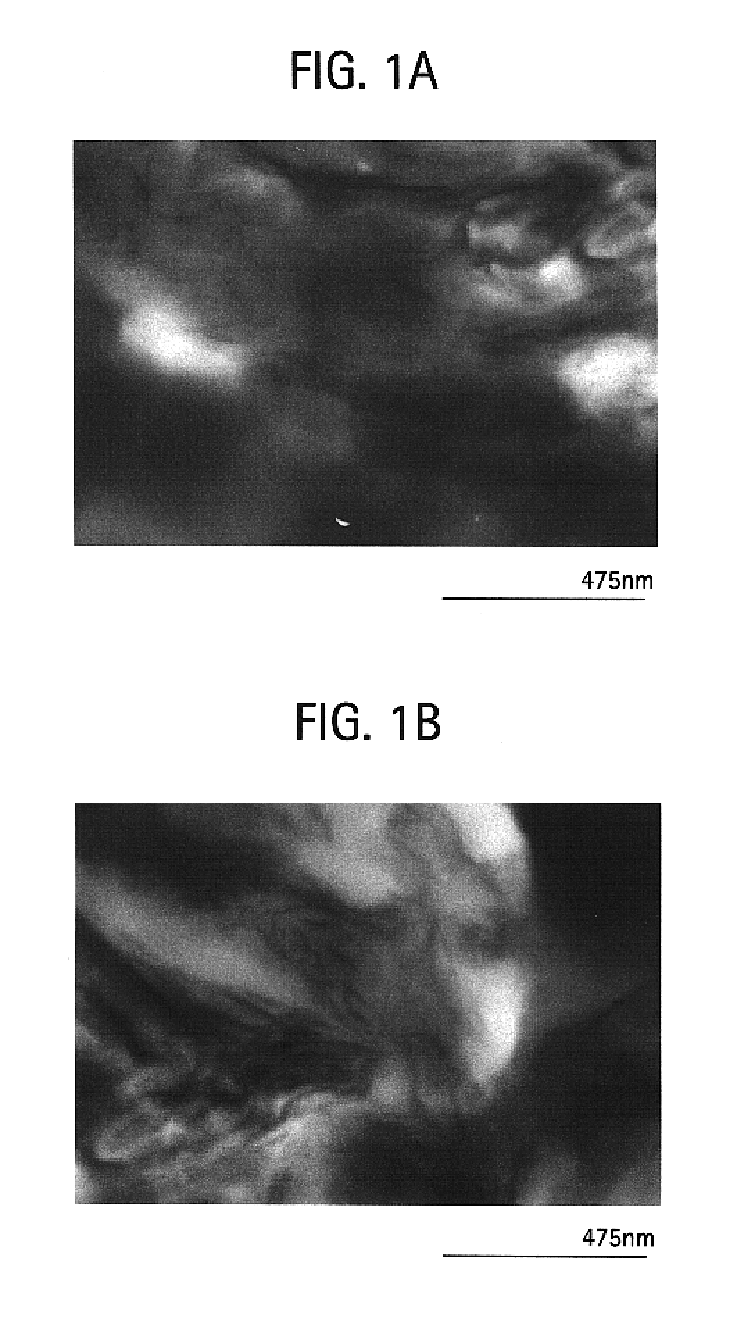Polyolefin-based nanocomposite and preparation thereof
a polyolefin-based, nano-composite technology, applied in the field of polymer nano-composites, can solve the problems of inferior usually clay materials, and the use of a catalyst for the modification of polyolefin, so as to achieve the effect of further improving the compatibility between the organic polyolefin and the inorganic dispersion phase, and being suitable for use in the industry
- Summary
- Abstract
- Description
- Claims
- Application Information
AI Technical Summary
Benefits of technology
Problems solved by technology
Method used
Image
Examples
example 1
Preparative Example 1
The Preparation of Modified Layered Clays Containing Multiple Epoxy Groups
50 grams of white montmorillonite (Clay 1,CEC=78 meq / 100 g, d-spacing=15° A., Taiwan PeiKon Ceramics Co., Ltd) was dissolved in 4000 ml of deionized water and agitated at room temperature for 4 hours to allow swell to give an aqueous solution of clay. 38.25 grams of octodecyldimethyl(3-trimethoxysilylpropyl)ammonium chloride (C18-N—Si) was then dissolved in 200 ml of deionized water to obtain a clear canary solution. 10.9 grams of coupling agent, 3-glycidoxypropyl-trimethoxysilane (S510, epoxy 1) was dissolved in a mixed solution of 10 grams of water and 15 ml of ethanol to form a clear solution. The S510 solution and the C18-N—Si solution were then mixed, and the temperature was raised to 80° C. and agitated for 20 minutes to form a solution of a quaternary ammonium containing multiple terminal epoxy reactive groups. Thereafter, the mixed solution of S510 / C-18-N—Si was added to the clay s...
example 2
Preparative Example 2
Blending of Modified Clays with PP-MA Compatilizer
The modified clay, clay 1-epoxy 1, obtained in preparative example 1 was poured into toluene, and agitated at 90° C. for 4 hours to completely swell the clay material. A polypropylene compatilizer solution was then prepared by dissolving Orevac-CA100, (Elf Atochem Co., Ltd. maleic anhydride-polypropylene copolymer, Mw=30000-50000) in toluene at a temperature of 110° C. for 20 minutes. The polypropylene comtatilizer solution was then blended with the swelled clay material at various weight ratios, i.e., 1 / 1, 1 / 2 and 1 / 3, and agitated at 110° C. for 1.5 hours to obtain a homogenous blend. The homogeneous blend was then evacuated and filtrated to remove the organic solution and dried in vacuum at 120° C. to prepare blends with different weight ratios of organomodified clay / polypropylene compatilizer.
examples 1-4
The Preparation of Polypropylene / Clay Nanocomposites
The blends prepared in the above preparative example were then dry mixed with polypropylene(Fu-Chu Company, Taiwan, MFR=13) and extruded using a twin-screw extruder (L / D=15, MP-2015). The kneading was conducted at a barrel temperature of 210° C., and at a screw rotational frequency of 25 rpm. The pelletized extrudate was molded into test samples and tested for mechanical properties and dispersibility. The results are set forth or shown in Table 2 below and the drawings.
TABLE 2d-spacingHeatClay 1-Clay 1-by XRDFlexuraldistortionPPepoxy 1epoxy 2analysismodulustemperatureAmount ofTest sample No.(wt %)┌PP┘ -MA (wt %)(wt %)(wt %)(° A)(kg / mm2)(66 psi) (° C.)ash (wt %)comparative100000—174.751200example 1example 1801001034 (broad198.1133.9(nano- ┌PP┘ -1and weak)example 2801010031 (broad196136.14-6(nano- ┌PP┘ -2)and weak)example 37020010no185134.34-6(nano- ┌PP┘ -3diffractionon peakexample 47020100no191137.64-6(nano- ┌PP┘ -4diffractionon pea...
PUM
| Property | Measurement | Unit |
|---|---|---|
| temperature | aaaaa | aaaaa |
| size | aaaaa | aaaaa |
| weight | aaaaa | aaaaa |
Abstract
Description
Claims
Application Information
 Login to View More
Login to View More - R&D
- Intellectual Property
- Life Sciences
- Materials
- Tech Scout
- Unparalleled Data Quality
- Higher Quality Content
- 60% Fewer Hallucinations
Browse by: Latest US Patents, China's latest patents, Technical Efficacy Thesaurus, Application Domain, Technology Topic, Popular Technical Reports.
© 2025 PatSnap. All rights reserved.Legal|Privacy policy|Modern Slavery Act Transparency Statement|Sitemap|About US| Contact US: help@patsnap.com



